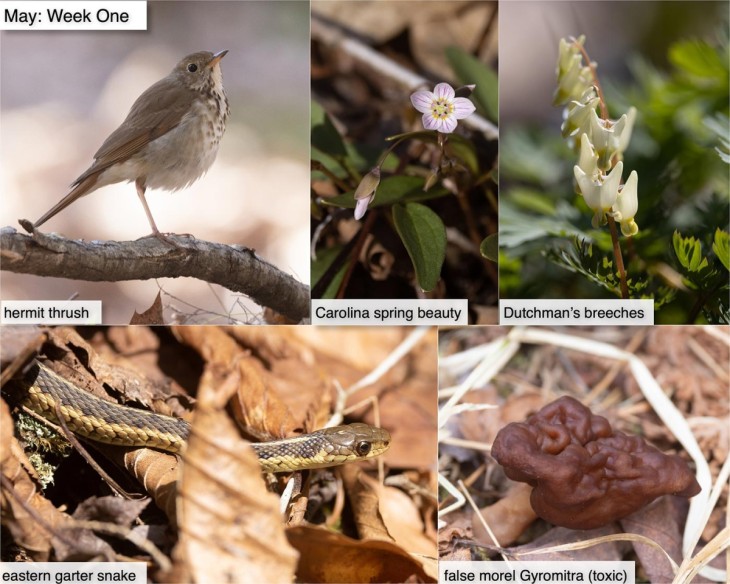This Week in the Woods, hermit thrushes are back and flitting around in pairs, with stops along the way to rummage in leaf litter for tasty invertebrates. One of the key identifying traits of these birds – as compared to wood thrushes, Swainson’s thrushes, and other almost-look-alikes – is that hermit thrushes’ tails are noticeably more ruddy colored than their brown backs. It’s always a joy to hear their flute-like calls, one of the great sounds of late spring. (For an audio sample, check out this page from Audubon.)
The spring flower show continues. We found many blooming patches of Carolina spring beauty during the past few days. This flower and its cousin, Virginia spring beauty, have a special relationship with Andrena erigeniae, spring beauty miner bees, which collect the flowers’ pink pollen for their young. At least, the females do. The male bees basically just loiter around the flowers, waiting for romance.
Also in bloom: Dutchman’s breeches, so-named because their flowers (sort of) resemble upside-down puffy pantaloons. The yellow lobes at the lower part of the flower structure conceal the stamens. These flowers often appear in patches and are also distinguished by their pretty, fern-like leaves.
If you’re out in the woods and you find yourself standing among what look like pinkish-brown brains, please resist any urges to eat them. You are not a zombie, they aren’t actually brains, and, by the way, they aren’t morels, either. They are highly toxic Gyromitra fungi, which, when ingested, can (although not always will) produce all kinds of highly unpleasant and dangerous symptoms. But on the plus side, they’re consistently one of the first fungi we find in spring, typically near water in hardwoods stands.
Finally, a sharp-eyed Dartmouth student, Kalina Duncheva, pointed out this eastern garter snake as it slithered through a sunny patch of leaves. As Susan Shea noted in this Outside Story article, garter snakes are our northernmost living snake, ranging almost to the Arctic Circle. They stay underground in winter and early spring, but they’re out and moving again now, hunting for small prey including frogs, worms and insects. Often, you’ll find them basking on stone walls.
What have you noticed in the woods this week? Submit a recent photo for possible inclusion in our monthly online Reader Photo Gallery.


